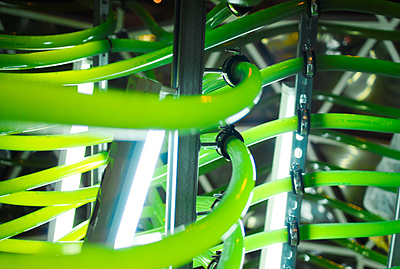Last week, a strange construction appeared at Blaha Lujza Square in Budapest. The work of Téreltérítés Munkacsoport (‘Deviant Space Working Group’) was connected to the capital's public space and art festival, called Placcc. The construction – “Downtown Smog Reducing Station” – was created following the plans of Richard Buckminster Fuller, and united several ideas about urban environment.
András Földes of Képgyár blog (‘Image Factory’, HUN) reported:
It could be known about the luminous igloo mounted at Blaha Lujza Square that it was the work of young artists and architects, and it cleans the smoggy air by biological means. Which is a noble goal, polluted air is bad after all, clean air is very healthy on the other hand. But still, the euphoria around the futuristic construction was surprising at first. […]
According to the website of Placcc festival:
Although the group includes future architects, they felt it was important to approach space from other aspects, not only and exclusively an architectural point of view, therefore they explore the relationship of man and space through art in public space. The starting point of the work they are making for PLACCC Festival is the belief that we are not mere observers of (public) space, but can actively shape it and participate in its transformation.
This photo, taken by Rozmy, shows the inside of the plastic igloo where the algae filtration was taking place:
András Földes asked the leader of Téreltérítés Munkacsoport about the functioning of the so-called ‘smog reducer':
[…] The leader of the project and [university] professor, Antal Lakner, explained ardently the functioning principles of the algae filtration bio-catalyzer, adding after each of his sentence that this thing really worked, that it wasn't just an object of art.
“Here an artist, an architect, a biologist and a technician worked together to resolve an existing problem,” said Lakner, a Hungarian Algae working helmet on his head. “A detecting car came here, and demonstrated that the plantation produced a significant amount of oxygen,” he said as he looked lovingly over the glass bubble occupied with silent oxygen production.








2 comments
I looked at this with great interest and wonder. Is the pipe HDPE (high-density-polyethyline? How about the skin of the dome? I am told that is the best material to use for this kind of thing. Mary